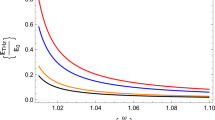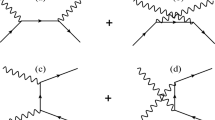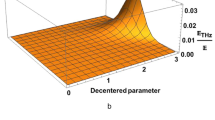Abstract
Bright, energetic, and directional electron bunches are generated through efficient energy transfer of relativistic intense (~ 1019 W/cm2), 30 femtosecond, 800 nm high contrast laser pulses to grating targets (500 lines/mm and 1000 lines/mm), under surface plasmon resonance (SPR) conditions. Bi-directional relativistic electron bunches (at 40° and 150°) are observed exiting from the 500 lines/mm grating target at the SPR conditions. The surface plasmon excited grating target enhances the electron flux and temperature by factor of 6.0 and 3.6, respectively, compared to that of the plane substrate. Particle-in-Cell simulations indicate that fast electrons are emitted in different directions at different stages of the laser interaction, which are related to the resultant surface magnetic field evolution. This study suggests that the SPR mechanism can be used to generate multiple, bright, ultrafast relativistic electron bunches for a variety of applications.
Similar content being viewed by others
Introduction
High energy particle bunches are a major tool in modern science and technologies1,2,3,4. In recent years ultra-short, high intensity laser pulses have emerged as compact drivers for high energy particle beams from various targets in different phases of matter1,2,3,4. It has however become obvious that further progress in laser driven particle beams requires smart manipulations of laser pulses and/or target properties. One nice example, is the invocation of the enhanced surface electric field created when such lasers im**e on a solid target that has modulated surface structures5,6,7,8,9,10,11,12,13,14,15,16,17,18,19,20,21,22,23,24. The structures can either be randomly oriented as in nanoparticle5 or nanotube6,7 coatings, or somewhat defined like aligned structures like nanorods8, nanotubes9, microspheres10,11 or well-defined modulations as in grating structures11,12,13,14,15,16,17,18,19,20,21,22,23,24,25,26. Although all these structures5,6,7,8,9,10,11,12,13,14,15,16,17,18,19,20,21,22,23,24,25,26,27,28,29,30 contribute to the enhancement of the laser absorption because of increase of interaction area and effects like the lightning rod31, grating structures11,12,13,14,15,16,17,18,19,20,21,22,23,24,25,26,27,28,29,30 were found to generate hotter and more copious flux of electrons via resonant excitation of surface plasmon, the so-called surface plasmon resonance (SPR).
The extrapolation of such behaviour to higher intensities is however still to be established because of potential damage to the grating structures by the rising edges and precursors of the ultra-intense laser pulses, which has so far been limited to moderate intensities14,15,16. Even after observation of higher energy of accelerated protons17 and efficient conversion of laser energy to electrons32,33,34 (using two-dimensional particle-in-cell simulations) on a grating target at relativistic intensity, it is still unclear whether SPR or local field concentration (similar to nano-size structure) governs the absorption mechanism. The Brunel absorption (vacuum heating)35, a well-known mechanism for absorption at high intensity laser pulses, has an optimum incident angle, and is governed by the plasma scale length at target front36. Such angular dependence also complicates the observation of SPR. Interestingly, periodically modulated/grating targets are found to be efficient for X-rays12, electron emission from target surface and front side15,16,27, and proton acceleration17. Also, these targets are explored intensively to generate higher harmonic18,19,20,21,28, and steady magnetic fields26. A recent summary of the subject can be found in Ref.22.
Here we demonstrate efficient coupling of relativistic intensity (~ 1019 W/cm2) femtosecond laser pulses to grating targets via SPR, resulting in the generation of bright, energetic (MeV), bi-directional electron bunches. We also compare two distinct cases satisfying resonant and non-resonant conditions using two types of gratings with different groove lines per mm as well as planar targets. In addition to, all previous results on high field surface plasmonics showing electron emission tangent to the surface22,23,24,25,26,27,28,29, we demonstrate electron bunch formation at angles decided by the grating parameters, suggesting tailored relativistic electron beams from periodic modulations. Incidentally, tangential emission has also been seen in plane targets with pre-plasma37, indicating that the enhanced emission due to surface plasmon excitation in these other studies22,23,24,25,26,27,28,29,30 may not be qualitatively different in nature. We have performed two-dimensional particle-in-cell (2D-PIC) simulations, which agrees well with experimental observation and also provide further insights into the involved physics. Apart from all previous studies11,12,13,14,15,16,17,18,19,20,21,22,23,24,25,26,27,28,29,30, we demonstrate emission of electron pulses at the grating target rear, away from other noise sources and debris at the target front. Our study also indicates efficient absorption of the laser energy by the grating structure, which should be of considerable interest for a gamut of applications, such as hard X-ray sources10,11,12,38, high harmonic generation18,19,20,21,22,23, fast electron and fast ion sources37,39, and fast electron microscopy40.
Experimental setup
The experiment is performed using a 100 TW, 30 fs, 800 nm laser system at the Tata Institute of Fundamental Research (TIFR), Mumbai. These p-polarized laser pulses are focused on to the target using an f/3 off-axis parabolic mirror at 40° incidence, corresponding to a laser ellipsoidal spot size of 5 µm × 8 µm and focused peak intensity of 1 × 1019 W/cm2. A schematic of the experiment is shown in Fig. 1 (see Methods).
Schematic of the experimental setup. The angle of incident of interaction laser (40°) is maintained for Gr500, Gr1000, and plane Au foil. Image plate (covered with appropriate thickness of aluminium filter) is placed behind the target to measure electron angular distribution. The energies of fast electrons emerging at target rear are measured by independent electron spectrometers located along three different directions to the target (40°, 90°, and 150°). The interaction laser contrast (bottom left) and atomic field microscopic (AFM) images of the grating targets (bottom right). Plasma emission is measured at the front side of the target at specular direction. L: Lens, BG39: A Schott BG-39 filter, SP: spectrometer.
In the experiments we used two types of sinusoidal grating targets (fabricated in house) with groove density of (i) 500 lines/mm (Gr500) and (ii) 1000 lines/mm (Gr1000). Atomic field microscopic images are shown in the inset of Fig. 1. Gr500 and Gr1000 are etched to a depth of 100 nm, on 1 µm thick Au coating on 76 µm thick polyester substrate, thereby yielding total target thickness of 77 µm. We use 2.5 µm thick Au plane foil and 50 µm thick polyster substrate (mylar) as a reference target. The SPR angle of the grating is experimentally confirmed by measuring laser reflection using a Ti-sapphire oscillator at 800 nm both in the continuous-wave and mode-locked states (see Methods). This angle is further verified by 10 Hz amplified pulses at very low intensity that is less then ablation threshold. The sharp drop in reflectivity (large absorption) (SPR angle) for Gr500 (Gr1000) is observed at the angle 40° (17°) (Fig. 2a). The sharp drop in reflectivity (large absorption) (SPR angle) is observed at the angle 40° (Fig. 2a) for Gr500; and 17° for Gr1000 (Supplementary Material, Fig. S1). These results clearly show our grating target works properly in SPR angle.
The laser pulses have an intensity contrast of 4 × 10–8 up to 10 picosecond prior to the peak intensity, as shown in the inset of Fig. 1. The nanosecond precursor of the main laser pulse is at the level of 10–9. The intensity of both picosecond and nanosecond portions before the main femtosecond laser pulse is therefore below the damage threshold of the target material. An intense pre-pulse (> 1010 W/cm2) or a longer intense main interaction laser pulse (> 100 fs) can significantly deform grating target surface, and can hinder SPR condition. However, with the present generation high intensity, femtosecond lasers, SPR conditions are accessible due to typical available high contrast (> 10–8) and thereby lower pre-plasma levels. The energy in our pre-pulse may not be enough to produce a pre-plasma. It is well known that the three half’s harmonic (532 nm) emission caused by two plasmon decay (TPD) is a good indicator of presence of significant pre-plasma41,42,43,44. Our measurements (see Methods) did not detect any noticeable 532 nm emission indicating the pre-plasma is insignificant under our experimental conditions (Fig. 2b). Any residual effect of such pre-excitation is assessed from a comparison of the different grating structures (resonant and non-resonant cases). These p-polarized laser pulses are focused on to the grating target using an f/3 off-axis parabolic mirror at 40° incidence. Note that this angle satisfies SPR condition for Gr500 target only. The focal spot size is ellipsoidal shape of 5 µm × 8 µm to cover few periods of gratings for excitation of SPR.
Results and discussion
Plasma emission
Grating targets are irradiated using an intense laser pulse at incident angle of 40° (Fig. 1). Figure 2b shows plasma emission spectrum (in the range of 300–700 nm).
We could not detect any measurable 3/2 harmonic (532 nm) emission peak even at the highest possible intensity of 1019 W/cm2. The absence of two-plasmon decay signal (emission at 532 nm) is also clearly indicating the absence of micron-scale pre-plasma41,42,43,44 in the present study. This is also established in our recent measurementsFull size image
To understand the effects of grating structure on electron acceleration and emission, we analyse the electron dynamics systematically. Three distinct stages of electron motion and thereby electron angular distribution is found. Figure 5c shows the electron emission detected at the Stage 1 at the rising edge of the laser pulse, before the laser peak arriving at the target surface (0–35 T0); the Stage 2 after the laser peak until the upper-forward electrons fade away (36–60 T0); and the Stage 3—after Stage 2 until all the detectable electrons vanish (61–100 T0). During these three stages fast electrons are emitted at 120°, 150°, and 40° directions, consequently. As the number density of electrons is relatively weak during the Stage 1 (red curve in Fig. 5c), the dominant electron emission peaks are seen at 150° (green curve in Fig. 5c) and 40° (blue curve in Fig. 5c). The angular distribution of electron emission (Fig. 5b) thus matches very well with that from the experiments (Fig. 3e). Our simulation shows that electron emission along the laser propagation direction is suppressed, which is attributed to the increased surface fields and the modulation of the p-polarized laser pulse by the grating surface. The v × B motion of electrons is heavily affected and suppressed. This is consistent with experimental observations. This also establish the relevance of grating geometric effects along with SPR.
Next, we retrospectively track some trajectories of electrons, as shown in Fig. 6a. Electrons are initially pulled out of the target and then gets injected back. Electron dynamics in Stage 1 is very similar to the Brunel heating mechanism35. They are first pulled out by the electric field of laser and pushed back in the next half period, as shown in Fig. 6b. In the meanwhile, there is quasi-static magnetic field generated on the surface due to the grating structure. Through the surface magnetic field49, fast electrons are deflected at an angle of θ ~ eBL/γmec ~ 30° (120° to the tangent), where B ~ a0meω/2e is the estimated magnetic field and L = c/ω is the thickness of surface magnetic field in Fig. 6b.
(a) Trajectories of fast electrons in the three distinguished stages of laser pulse irradiation. The colorbar represents the simulation time (T0). Stage 1: 0—35T0, Stage 2: 36—60T0, Stage 3: 61—100T0. (b) Quasi-static magnetic field Bz at t = 25 T0 and two selected electron trajectories around this time. (c) The transient field Ex at t = 35 T0 and four selected electron trajectories around this time, where an electromagnetic field component is shown to propagate along the tangent direction in addition to the reflected laser (green dashed line). (d) Surface electric field Ex for Gr500 and Gr1000 at t = 30T0, the moment at which the laser peak im**es on the target. Bz and Ex are normalized by meωc/e.
In Stage 2, the surface plasma waves begin to play a major role in fast electron generation. Figure 6c shows the instantaneous electric field Ex at t = 35 T0. One can see an electromagnetic field component propagating along the tangent direction in addition to the reflected laser (green dashed line Fig. 6c). The electrons which are initially accelerated by the laser field through the Brunel mechanism gets further accelerated by the surface electromagnetic waves; however, the acceleration is soon de-phased as the phase velocity of surface fields is larger than the electron speed. In the present case, the final electron energy is around 200 to 800 keV with the velocity about 0.9 to 0.96 c. After separating from the surface electromagnetic fields, the electrons are pushed forward by the electrostatic field Ex (~ 2 × 1012 V/m) and meanwhile deflected by the magnetic field Bz (~ 54 MG) built around the target. The motion equation of these electrons is dθ/dx = eB/p, where p = γβmec is the electron momentum and γ = eExx/mec2 + 1 is the Lorentz factor. It is found that the acceleration length is approximately x = H + L, where H = 100 nm is the groove depth of grating. Figure 7 shows the electron density flux for Gr500 at t = 27 T0 (Fig. 7a) and 40 T0 (Fig. 7b). Low energy electrons are represented by the red points (200 to 800 keV), whereas energetic electrons are represented by blue points (> 800 keV). The energetic electrons move 120◦ at the early stage, and then changes their direction towards 150◦ at the later time. Hence, one can estimate the deflection angle in Stage 2 to be θ ~ 60° (150° to the tangent). Although the energetic electron emission angle changes with time, the emission pattern still shows emission frequency close to incident laser frequency. This corresponds to the surface plasmon wave or vacuum heating mechanism.
Electron tracks in Stage 3 appear complicated but also unambiguous and explainable. The origin is no longer the Brunel electrons. In the laser falling edge, the reflected laser is stronger than the incident one. Some electrons are directly accelerated by the reflected laser. However, a part of these electrons will be pulled back by the sheath electric field and undergo approximately specular reflections at each side. Since the target is of finite dimension, these fast electrons will be bounced back by the sheath electric field and finally emit from the rear of the target where the sheath electric field is very weak after the laser im**ing. As discussed above, the electron acceleration using grating targets is finally determined by the surface electrostatic field Ex and magnetic field Bz. Such fields at the front surface will be highly enhanced under the SPR condition. The fields at the rear surface will be indirectly enhanced due to the larger electron flux and current.
Two typical trajectories for such electrons’ emission at this stage are shown in Fig. 6a. The electrons firstly experience transverse deflection at the rear side of the target and then transmit through the target due to the sheath field. In the front side, they experience similar process and finally go through the target with an emission angle of 40°. Such transverse deflection results from the combined effects of the quasi-static electromagnetic fields Ex and Bz around both the front and rear sides of the target and is related to the E × B drift, which can be clearly seen from the typical trajectory (Fig. 6a) and the fields at rear side (Fig. 8a–c). The fields are at a fixed time (t = 60 T0), so the integration effects cannot be clearly seen. However, they are relatively slowly varying fields. The combined effects of the quasi-static electric and magnetic fields lead to the electron reflection. These results are consistent with earlier simulations by Bigongiari et al.26 who showed that (a) the surface plasmon wave can significantly enhance the quasi-static magnetic fields at the surface; and (b) these intense localized magnetic fields can determine the divergence and flux of the energetic particles in the beam. Figure 6d compares the Ex fields at the laser peak moment for grating targets with different grove spacing. The Ex for Gr500 is 1.5 times larger than Ex for Gr1000. This leads to the increase of electron energy and number simultaneously, and thus 2.3 times enhancement of flux for Gr500, which are similar as those observed in the experiments shown in Fig. 3e.









